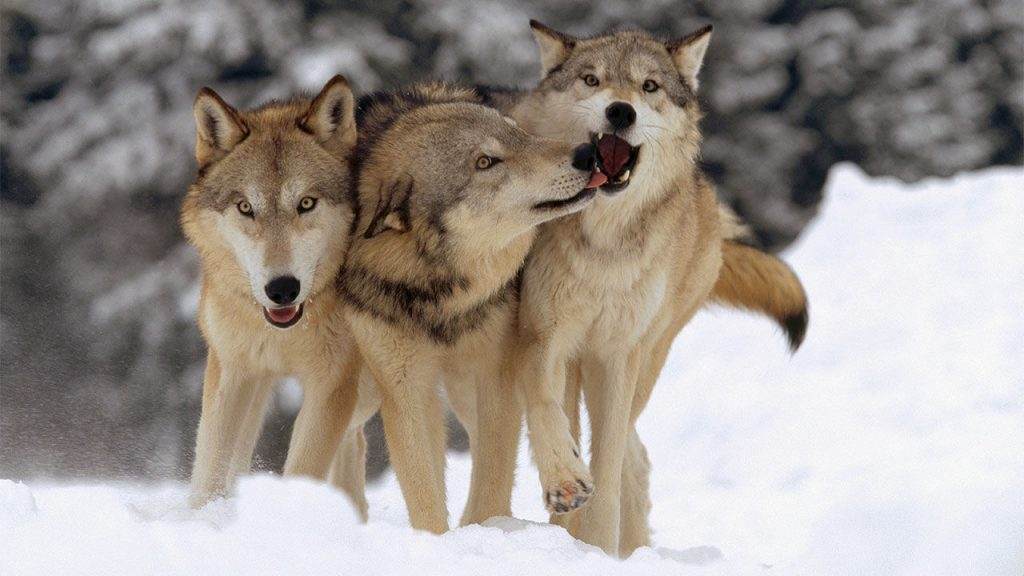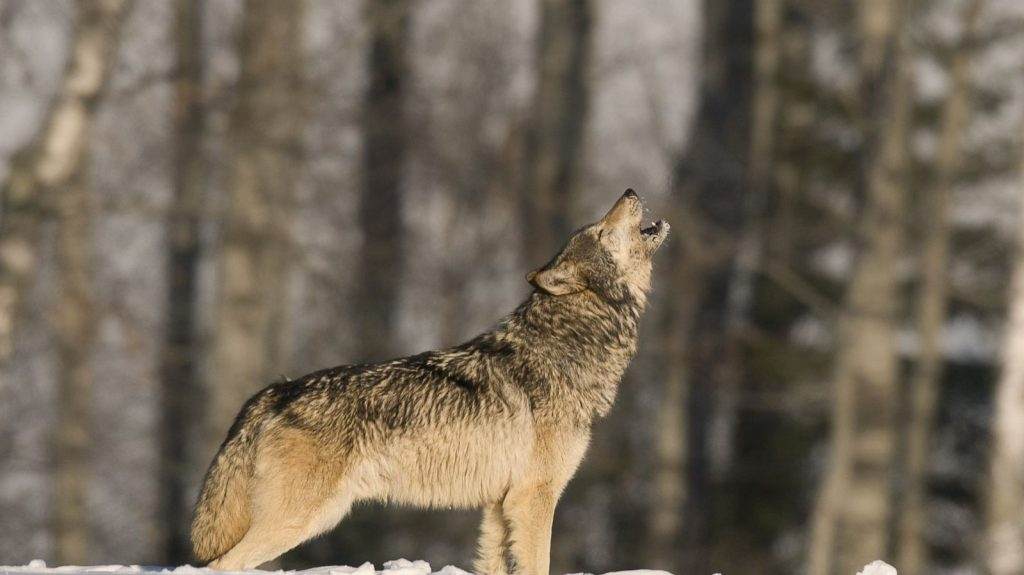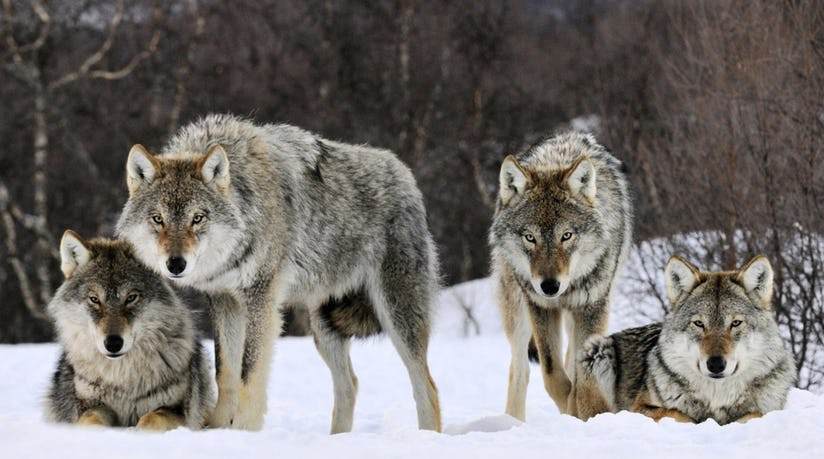As known descendants of wolves, dogs inherit certain traits from their wolf ancestors. While there are striking similarities between dogs and wolves in terms of social behavior as well as physical characteristics, there are also significant differences between the two.
An important question that has overwhelmed many observers of the two species is the sound and method of communication used by each.

Discussions on barking in wolves have been quite prolific, as dogs too are accustomed to barking. However, as we begin to analyze the two barks we have to understand that the bark of a wolf is very different from that of a dog.
Technically, a wolf can bark and it often uses barking as a potent defense mechanism. This bark is quite different from that of your dog, in terms of both the texture of the sound as well as the intention of its production. Moreover, although wolves can bark, they use this form of communication relatively infrequently.
Growling is the most common form of communication used by wolves, followed by whimpering and whining. On the other hand, dogs are known to commonly use barking as a preferred method of communication over whimpering.
There are several other differences between the bark of the two species as well as important historical factors that have produced these differences over time.
Communication Mechanisms of a Wolf

Wolves use a wide repertoire of communication mechanisms that are highly sophisticated. They use different forms of vocalizations to communicate with their packs. As one of the most social species, their communication systems are highly complex.
There exists a complex hierarchy in a wolf pack. To effectively maintain this hierarchy, advanced communication mechanisms are essential. Howls, whimpering, growls and barks are common among these methods of communication.
Wolves may also communicate with each other using a combination of these sounds, instead of a single mechanism. Each vocalization has a significant meaning attached to it and is used in a specific context.
What is the Meaning of Each Sound?
The most commonly associated sound with wolves is howling. The general misconception that wolves simply howl at the moon is flawed; rather they howl to communicate.
Howling is used by them to effectively communicate with other members of the pack across long distances. It is also sometimes used as a defense mechanism to keep young pups safe and to warn the pack of incoming danger. It is also used to gather the pack and mourn the loss of a member.
Howling may also be social to help a lone wolf locate others in the region. It may be used to mark territory and help gather the lost members of the pack. Usually, wolves howl once or twice every day. Moreover, wolves do not just howl at night. They may howl at any given time of the day. The sound of a howl is much easily audible at night due to the lack of wind.

Growling is a sound used by wolves to issue a signal of warning. Snarls are also used to convey a similar feeling. It may growl to indicate danger or assert dominance. These sounds are most commonly used by the wolf to communicate with its pack members.
Whimpering signifies a sound of submission by the wolf. It can be used as a way of expressing frustration and apprehension as well. The meaning of a particular whine or whimper depends on the context of its display as well as the body language of the wolf.
Whining and whimpering is also commonly used in friendly encounters. Lastly, barking is also a sound emitted by the wolf to communicate a warning signal. It may bark upon sensing danger to the pups or the pack. It may also be a sign of aggression displayed as a defense mechanism to protect the pack.
When Do Wolves Bark?

The instances of a wolf barking are quite uncommon. They usually resort to other modes of communication than barking. This is a significant difference between a wolf’s and a dog’s barking propensities. Dogs tend to bark quite frequently as compared to whimpering.
For the wolf, this sound is used relatively uncommonly as it is essentially a sound of alarm. Wolf pups are more commonly known to bark than mature adults. Moreover, barking is seldom used as a sound alone. It is often used in conjunction with some other form of vocalization- like the howl or the whimper. This produces a peculiar soundscape known as the bark-howl and a bark-whimper.
Barking is also commonly used by the mother wolf to communicate with its pup. If the pup is in danger, the mother wolf will use barking as a way to communicate a warning about the impending danger to the pup. Alternatively, if the pup does something that annoys the mother, she may use barking as a method to communicate this annoyance.
Bark-howls are also commonly used to ward off intruders near the den area. They may also be used to defend the pack’s territory.
When Does a Dog Bark?

To differentiate the bark of a dog from that of a wolf, we need to understand why each of these sounds is emitted by the animals. The bark of a dog is not only different in terms of its texture and meaning but also in terms of its intentioned use.
While dogs also bark to communicate certain emotional states, the connotation of these barks are quite different from that of a wolf’s. Frequent barking is more common among some breeds than others. Moreover, training and socialization play key roles in determining the frequency of barks.
Dogs can be trained to reduce their barking frequency. Their physical condition of living is seminal in determining the frequency of barks. If there are factors in the physical environment that agitate your dog, the dog is bound to bark more often.
Why Do Dogs Bark?

They may bark commonly to draw your attention toward them, to signal a need that has to be met or to express states of anxiety or excitement. Most commonly dogs bark to communicate that a certain requirement has not been met. For instance, they may bark when they are hungry and have not been fed or when they are thirsty and there is insufficient water.
They may bark to communicate their sense of discomfort or agitation as well. Dogs use barks as the most common method of communicating with humans. They too have some other sounds in their communication repertoire, however, barking is the most commonly used sound.
Barking is also used by dogs to communicate a sense of excitement or anxiety. Much like wolves dogs too bark both during the day as well as night. The reasons for barking at night are the same as the ones that make them bark during the day.
Why is a Dog’s Bark Different?
After comparing the reasons for barking we can conclude that both dogs and wolves bark, however, their barks are remarkably different from each other. The reason for the development of this difference is years of evolution.
Evolution coupled with the domestication of dogs has produced this vast difference in their barks. Researchers believe that the evolution of social behaviors is invariably affected by the social group in which an organism grows. The close association of dogs with human beings has resulted in the bark becoming different.
This has also changed the meaning associated with their barks. Dogs picked up on the fact that humans understand vocal cues much better than non-verbal ones. To communicate with the human master, the dog needed some form of vocal mechanism.

Moreover, behaviors are often products of learned actions. Early socialization is key to learning certain behavioral traits. Barking is considered to be one such trait. By living in a social group organisms learn social behaviors.
Thus, a wolf learns to bark in certain social contexts because it has learned to do so in its social group. This learned form of communication is necessary for its survival. Without learning the wide repertoire of communication, a wolf cannot hope to survive in the wild, especially because wolves are an extremely social species.
On the other hand, the dog’s social group comprises of humans. The process of domestication altered the requirement of learning vocalizations for survival in the wild. Communication for dogs is rooted essentially in survival among humans. Their communication patterns have been altered due to them becoming well-acclimated to lives with human partners.
The learned behavior here is that dogs that can communicate best with humans will have a high possibility of a happy and healthy survival. They have learned that their new social group – comprising of humans- understands and responds to vocal cues like barking and whimpering.
By a method of trial and error dogs also learned over the years that barking is the most effective vocal cue they can use. Other cues like whimpering and howling are also effective but barking remains the most effective and frequently used vocal cue.
This form of communication was then passed on from one generation of the dog to the next- effectively becoming an indispensable part of their communication repertoire.
Dogs Use Different Tones of Barking

Scientific research on barking has been relatively limited. However, the marginal research conducted in this domain suggests that the bark is the most commonly used sound by the dog. It was also noted that the tones of barking are quite varied- varying across breeds as well as on an individual level. The main cause of this difference is the purpose of the bark.
Each specific dog influences the tone and function of each type of bark. The job or work performed by individual breeds also has a bearing on the kind and tone of barks used by the dog. Thus, the bark of a hunting dog may be different from toy dogs.
Moreover, research suggests that as dogs continue to evolve, they learn to specify their barks in terms of its tone and kind- to develop the most effective form of communication with its owner. In a way, the dog learns to customize its bark according to the response rate of its owner.
Each specific communication is a learning curve that enables a dog to develop the most efficient and suitable way to communicate with each specific human.
Conclusion
As we have seen that even though both dogs and wolves share the same family tree, have similarly shaped voice boxes and also share the ability to bark, the tone, texture and meaning of their barks are significantly different. Wolves have learned to bark as a mechanism of natural and social selection.
This is an important survival strategy used by wolves to ward off predators and intruders. This survival strategy as a vocal mechanism is passed on from one generation to the next. In the case of the domesticated dog too, survival instincts guide the barking propensity.
Adapting to living among humans, dogs learned to effectively communicate with their human partners through barks. This was also a survival strategy passed on from one generation to the other. They understood that humans respond better and faster to vocal cues.
This enabled them to develop a specific tone and purpose for the bark. Evolution and domestication were key factors in the development of a bark designed for humans.
Table of Contents





